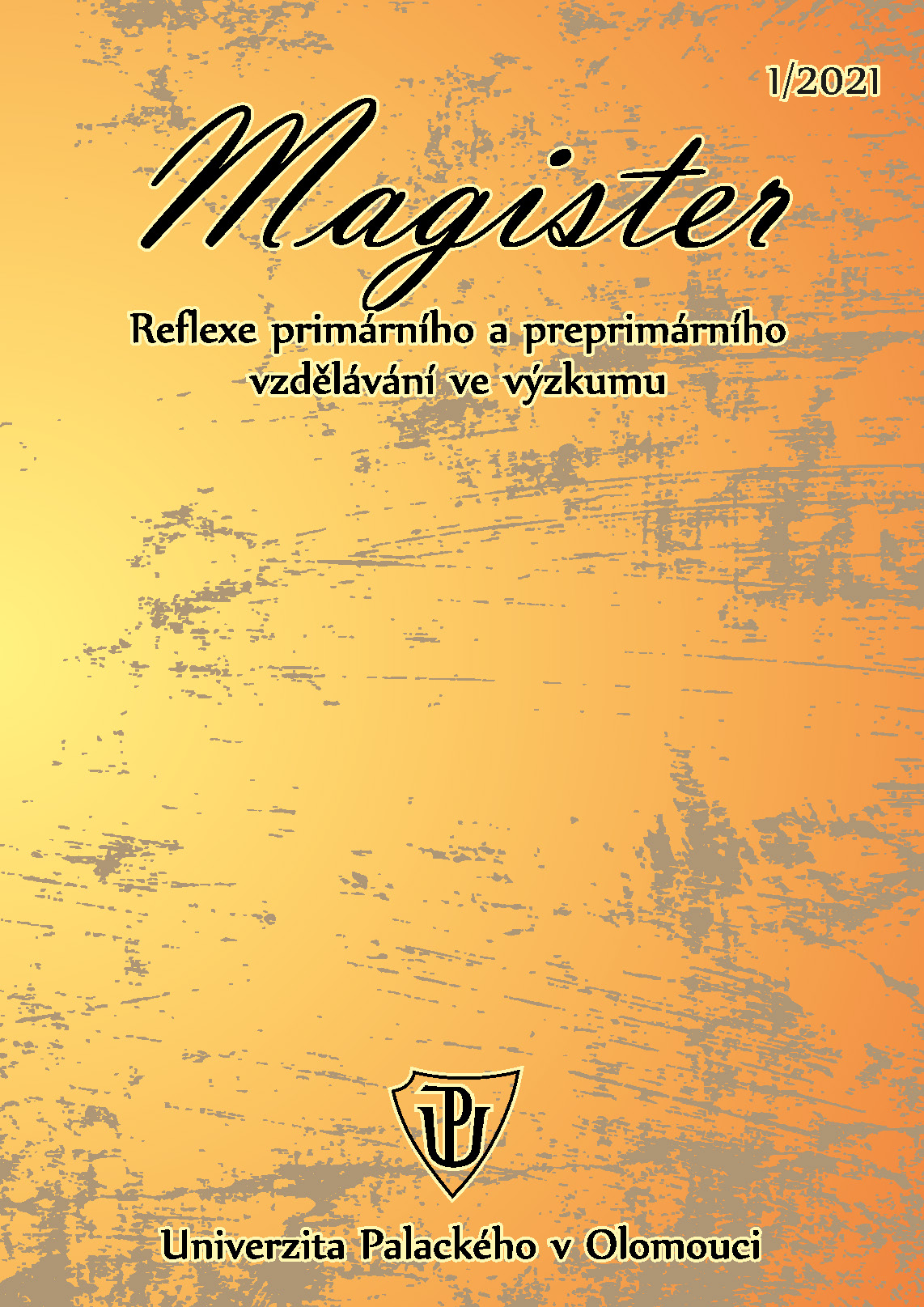Interest of pupils of the 1st grade of primary school in physical activities
DOI:
https://doi.org/10.5507/magister.2021.136Keywords:
Physical education, Primary school, Younger school ageAbstract
In the context of school physical education, pupils should achieve the competences that will enable them in the later stages of their lives practice a physically active lifestyle. The aims of school physical education are therefore directed towards a number of areas, be it health prevention, the development and consolidation of physical and mental fitness and knowledge to support physical learning. An integral part of the formation of positive personal qualities and attitudes in pupils are the non-compulsory organisational forms of physical education that many schools in the Czech Republic offer. The present research investigation was aimed at describing and analysing the interest of primary school pupils in physical activities. The research population consisted of 5912 primary school pupils (3006 boys, 2906 girls). A high percentage (45%) of the children surveyed did not prefer to participate in leisure-time physical activities or did not participate at all in these non-compulsory forms of physical education offered by schools. The findings of the research show the necessity of improving the quality of school physical education, especially at the first level of schools, which is the basis for the implementation of a quality, healthy lifestyle of future adults.
References
Belej, M. (2001). Motorické učenie. Prešov: Prešovská Univezita.
Bell, S.L., Audrey, S., Gunnell, D., Cooper, A., Campbell, R. The relationship between physical activity, mental wellbeing and symptoms
of mental health disorder in adolescents: a cohort study. Int J Behav Nutr Phys Act. 2019 Dec 26;16(1):138. doi: 10.1186/s12966-019-0901-7. PMID: 31878935; PMCID: PMC6933715.
Cabrnochová, H. (2008). Výskyt nadváhy a obezity u českých dětí (online). [cit. 1. 12.2008]. Dostupné z: http://www.cabrnochova.cz/prednasky.html
Dietrich, K., Dürrwächter, G. Schaller, H. J. (1994). Die grossen Spiele. Aachen : Meyer und Meyer.
Dvořáková, H. (2006). Pohybové činnosti pro předškolní vzdělávání. Praha: Raabe. European Health Heart Initiative EHHI (2001) Children and Young People –the Importance of Physical Activity. A paper published in the context of the European Heart Health Initiative (Ed. Logstrub Sussane), Belgium, Brusel, 2006. https://www.prof-wendt.de/plaintext/downloads/physicalactivity 2001.pdf
French, K. E., Thomas, J. R. (1987). The relation of knowledge development to children’s basketball performance. In Journal of Sport
Psychology, č. 9, s. 15–32.
Frömel, K., et al. (2004). Pohybové zatížení mládeže České republiky. In D. Tomajko (Ed.), Efekty pohybového zatížení v edukačním prostředí tělesné výchovy a sportu (pp. 39–48). Olomouc: Univerzita Palackého.
Fürstová, M. (1997). Psychologie. Praha: Votobia.
Haskell, W. L. - Lee, I. M. - Pate, R. R. - Powell, K. I. - Blair, S. N. -Franklin, B. A. (2007/39). Physical activity and Public health. Medicine and Science Sports and Exercise, s. 1923-1434.
Hrčka, J., Michal, J., Bartík, J., & Krška, P. (2005). Afinita školskej mládeže na športovaní a jej skúsenosti so zakázanými drogami. Telesná
Výchova a Sport., 15(3, 4), pp. 5–10.
Karger, J. (1996). Jak trénovat? In Bulletin ČABT, č. 5, s. 15–18.
Kučera, M., Golebiowska, M. (1994). Evaluations of physical activity in obese individuals. Časopis lékařů českých, vol. 133, no. 4, s. 116-119.
Kunešová, M. Životní styl a obezita. (2006). Děti 6-12 let. Závěrečná zpráva pro MZ ČR a Českou obezitologickou společnost. stem/mark, a. s. [online]. [cit. 30. 6. 2011].
Lefevre, J., Bouckaert, J. Duquet, W., Van der Aerschot, H. (1999). Barometer of physical fitness in Flemish youth: Evolution of physical
fitness in Flemish youth (12 to 18 years old) in the nineties. Belgium: Koning Boudewijn Stichting.
Matějček, Z., Dytrych, Z. (1994). Děti, rodina a stres. Praha: Galén.
Perič, T. (2004). Sportovní příprava dětí. Praha: Grada Publishing.
RYCHTECKÝ, A. (2006). Monitorování účasti mládeže ve sportu a pohybové aktivitě v České republice. Praha: Univerzita Karlova v Praze,
Fakulta tělesné výchovy a sportu.
Salmon, J., Telford, A., Crowford, D. (2002). The children´s Leisure Activities Study. Summary report. Centre for Physical Activity and Nutrition Research. Deakin University. p. 14. Retrieved 11. 9. 2007 from World Wide Web: http://www.deakin.edu.au/hbs/cpan/ class_report-final1.pdf.
Sigmund, E., Frömel, K., & Neuls, F. (2005). Physical activity of youth: Evaluation guidelines from the viewpoint of health support. Acta Universitatis Palackianae Olomucensis. Gymnica, 35(2), pp. 59–68.
SLEPIČKA, P. a SLEPIČKOVÁ, I. (2002b). Zájem české populace o tradiční a nové sporty. In: Miler, T a Matolín, S. (Eds.) Půlstoletí tělesné výchovy na vysokých školách. Praha: Karolinum, s.73-78.
SUCHOMEL, A. Tělesně nezdatné děti školního věku (motorické hodnocení, hlavní činitelé výskytu, kondiční programy), 2006, 1. vyd. Liberec: TU, ISBN 80-7232-140-6.
Šimonek, Jaromír. .Metodika telesnej výchovy pre stredné školy. Bratislava, Slovenské pedagogické nakladateľstvo - Mladé letá, 2004 Tláskal, P. Obezita dítěte (tuková tkáň, rizikové faktory, prevence). (2006). VOX PEDIATRIAE, vol. 6, no. 3, s. 15-19.
Tomajko, D. (1996). Dynamický přístup k výuce sportovních her. In
Tomajko, D. (ed.) Didaktický proces v současném pojetí tělesné výchovy. Sborník z mezinárodního vědeckého semináře. Olomouc: Univerzita Palackého. ISBN 80-9676-923-5.
Tomajko, D., Adamus, M. (1995). Využití problémového vyučování při nácviku basketbalu. In Hra v životě člověka. Sborník referátů
z mezinárodní vědecké konference. Plzeň : Západočeská Univerzita.
Vágnerová, M. (2005). Vývojová psychologie I. – dětství a dospívání. Praha: Portál.
Vališová, A. - Kasíková, H. (2007). Pedagogika pro učitele. Praha: Grada Publishing, 2007.
Velenský, M. (1997). K problematice basketbalu ve školní TV. In Basketbal trenér, učitel, č. 1, s. 5–6. Výživa dětí. Sportovní aktivity podle věku [online]. 2011 [cit. 10. 9. 2011].Dostupné z: http://www.vyzivadeti.cz/pohyb/sportovni-aktivity-podleveku/#skolaci fórum zdravé výživy[online]. 2011 [cit. 1. 9. 2011]. Dostupné z: http://www.fzv. cz/files/images/mladsi%20deti%20FINAL.ppt
Zapletalová, L. (2003). Vztah mezi temperamentovými charakteristikami dětí, jejich pohybovou aktivitou a úrovní jejich pohybové výkonnosti. Acta Universitatis Palackianea Olomucensis. Gymnica, 33(1), pp. 11–18.
Downloads
Published
Issue
Section
License

This work is licensed under a Creative Commons Attribution-ShareAlike 4.0 International License.


